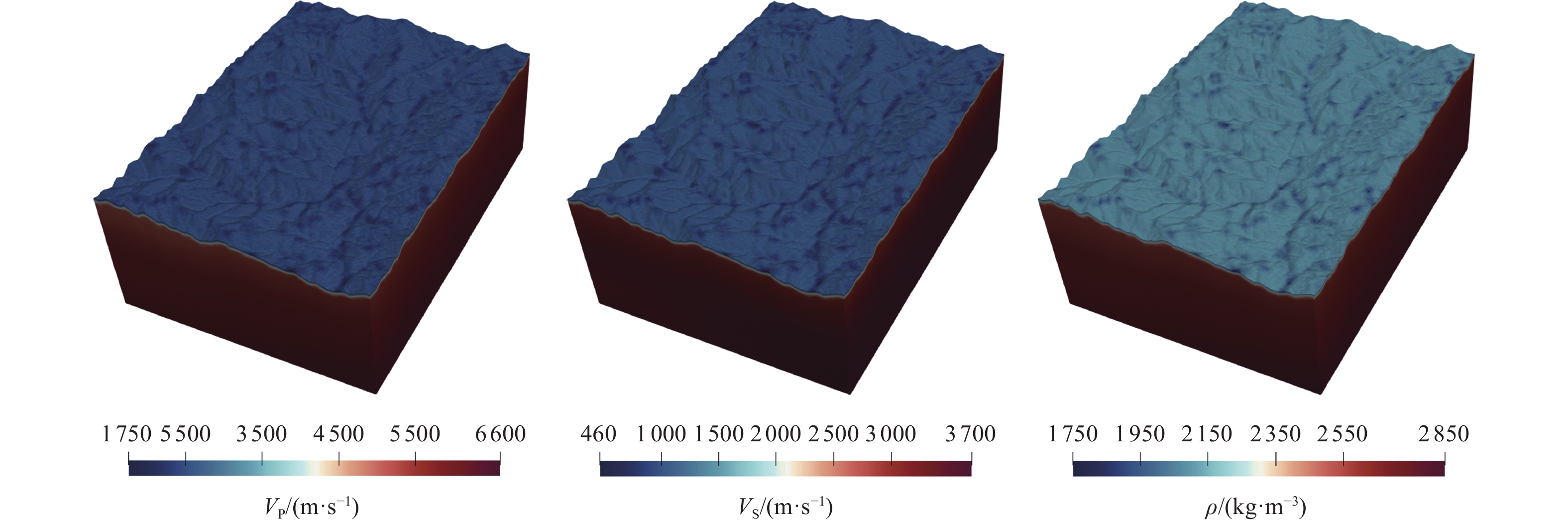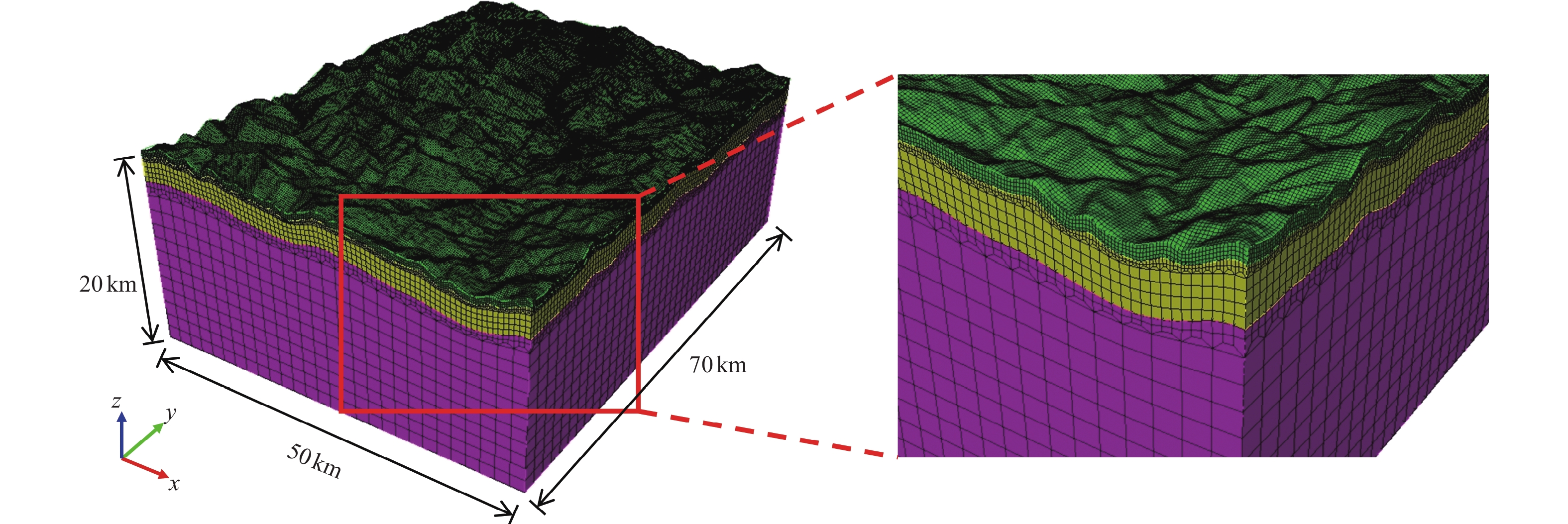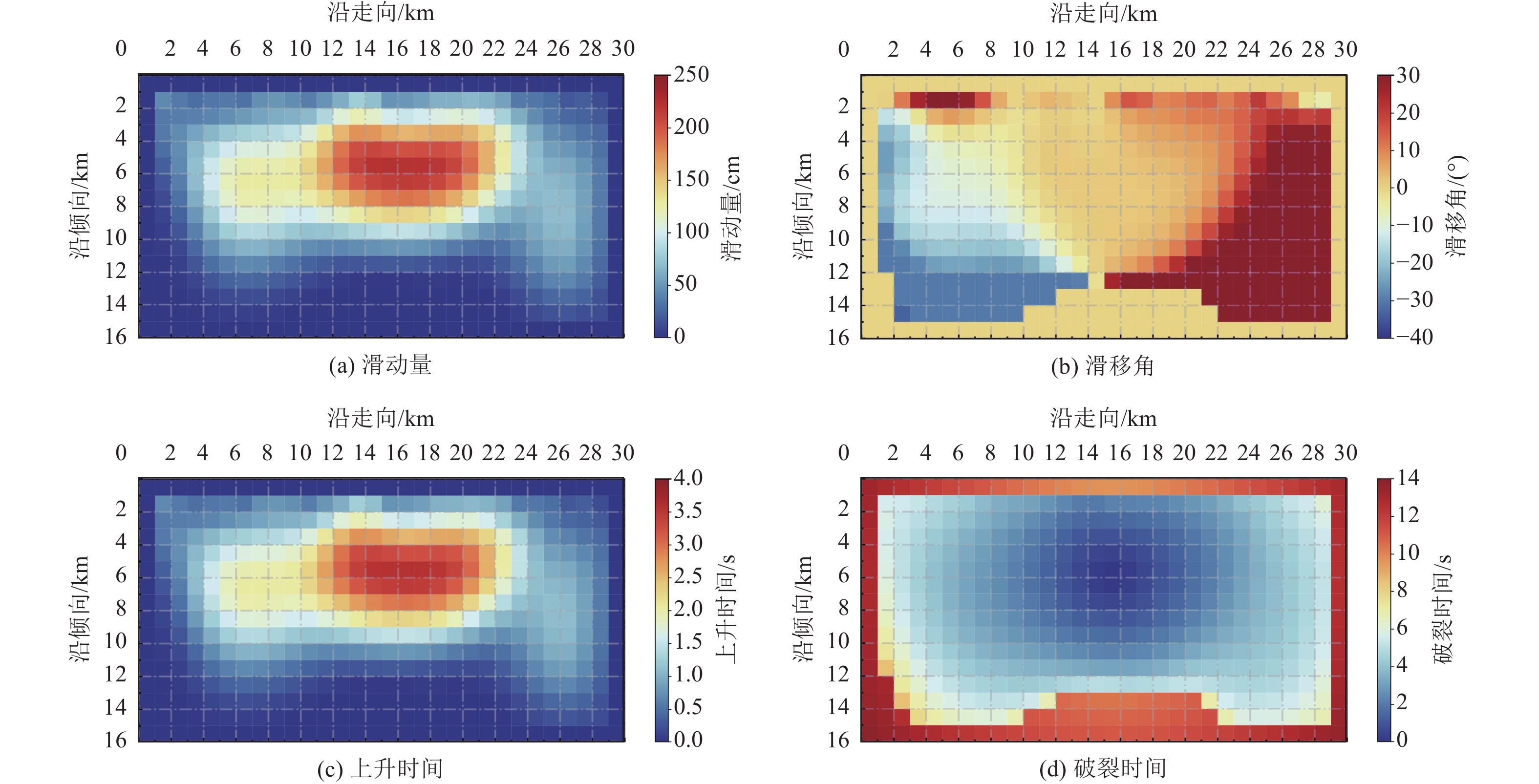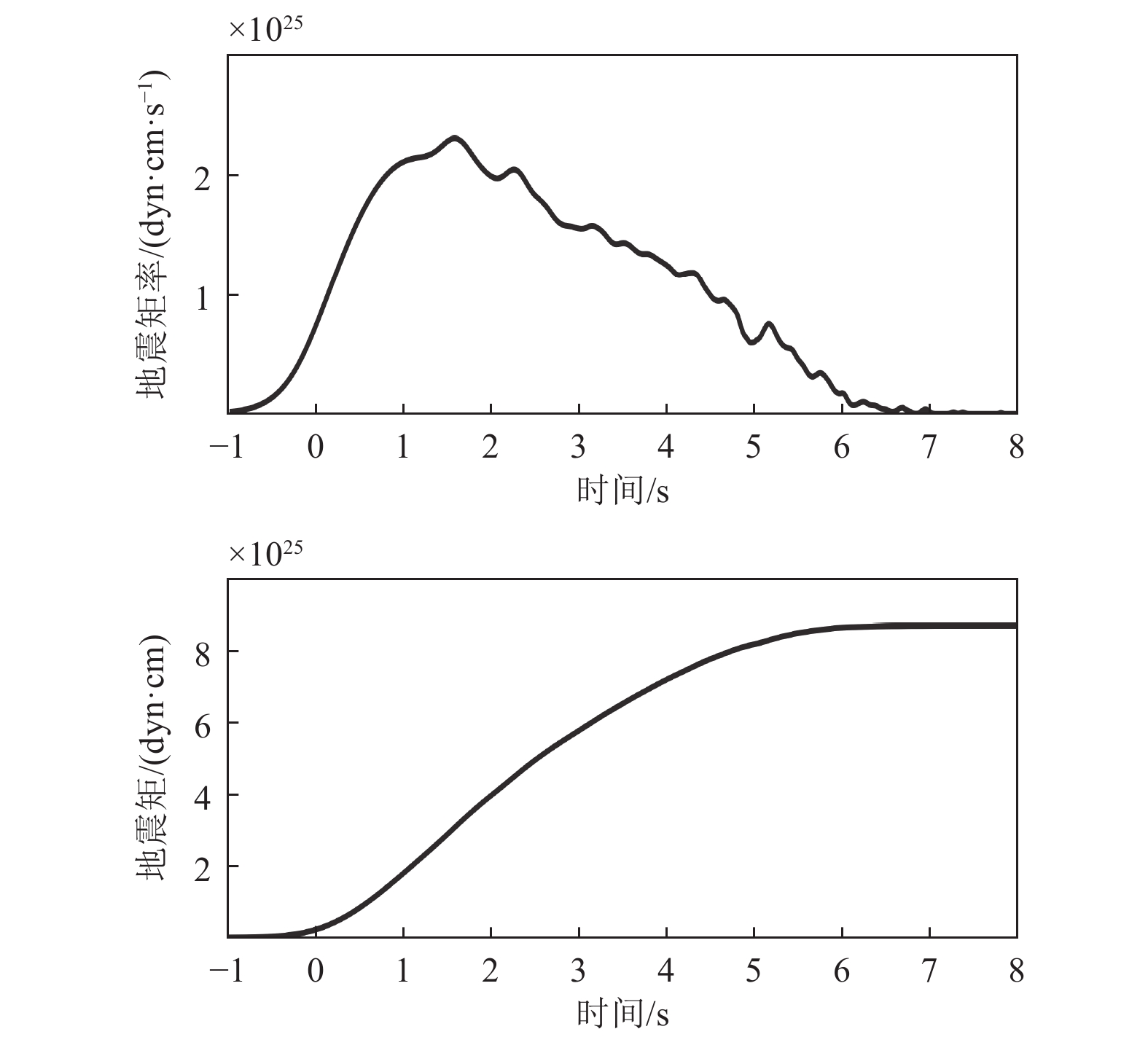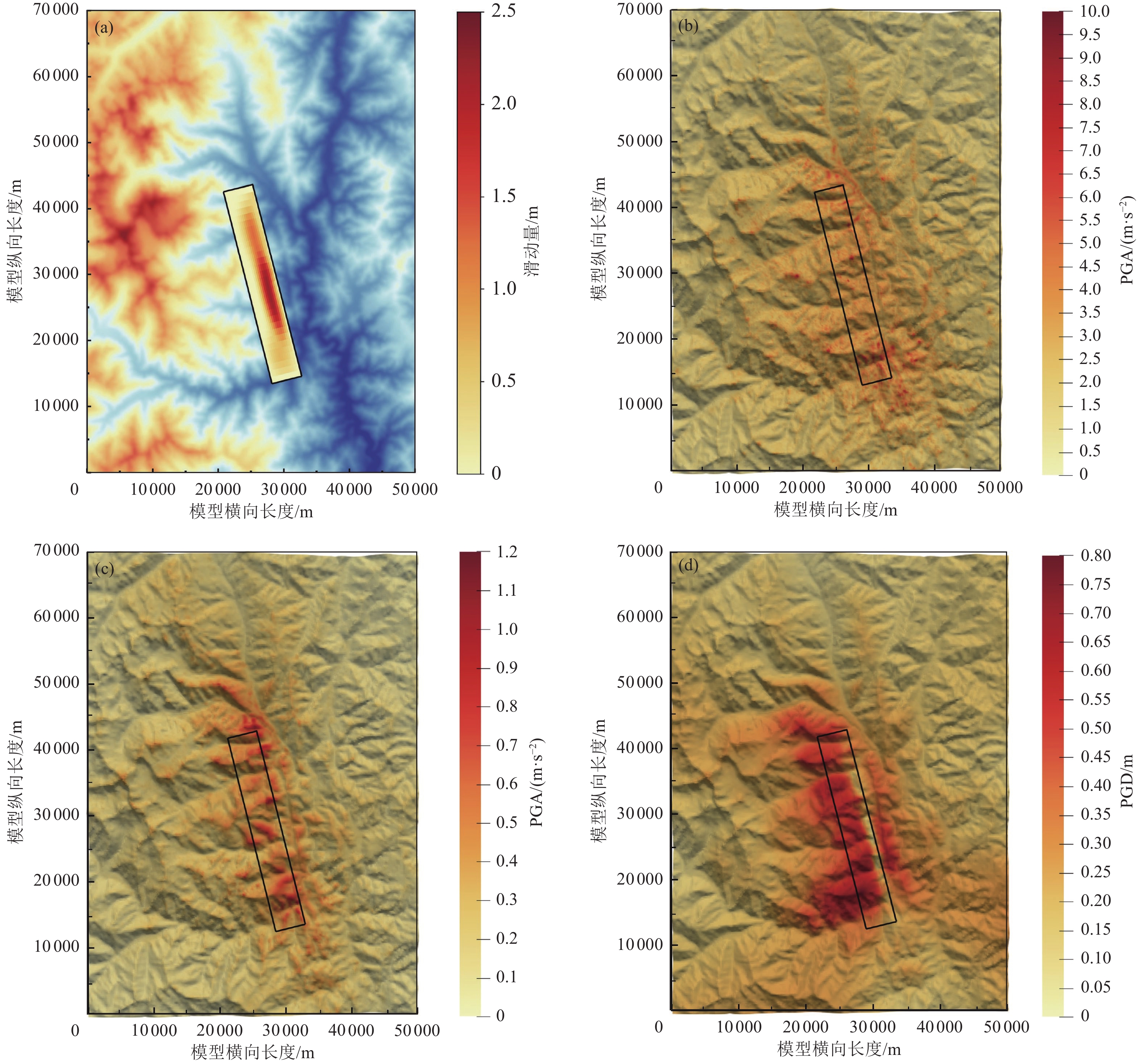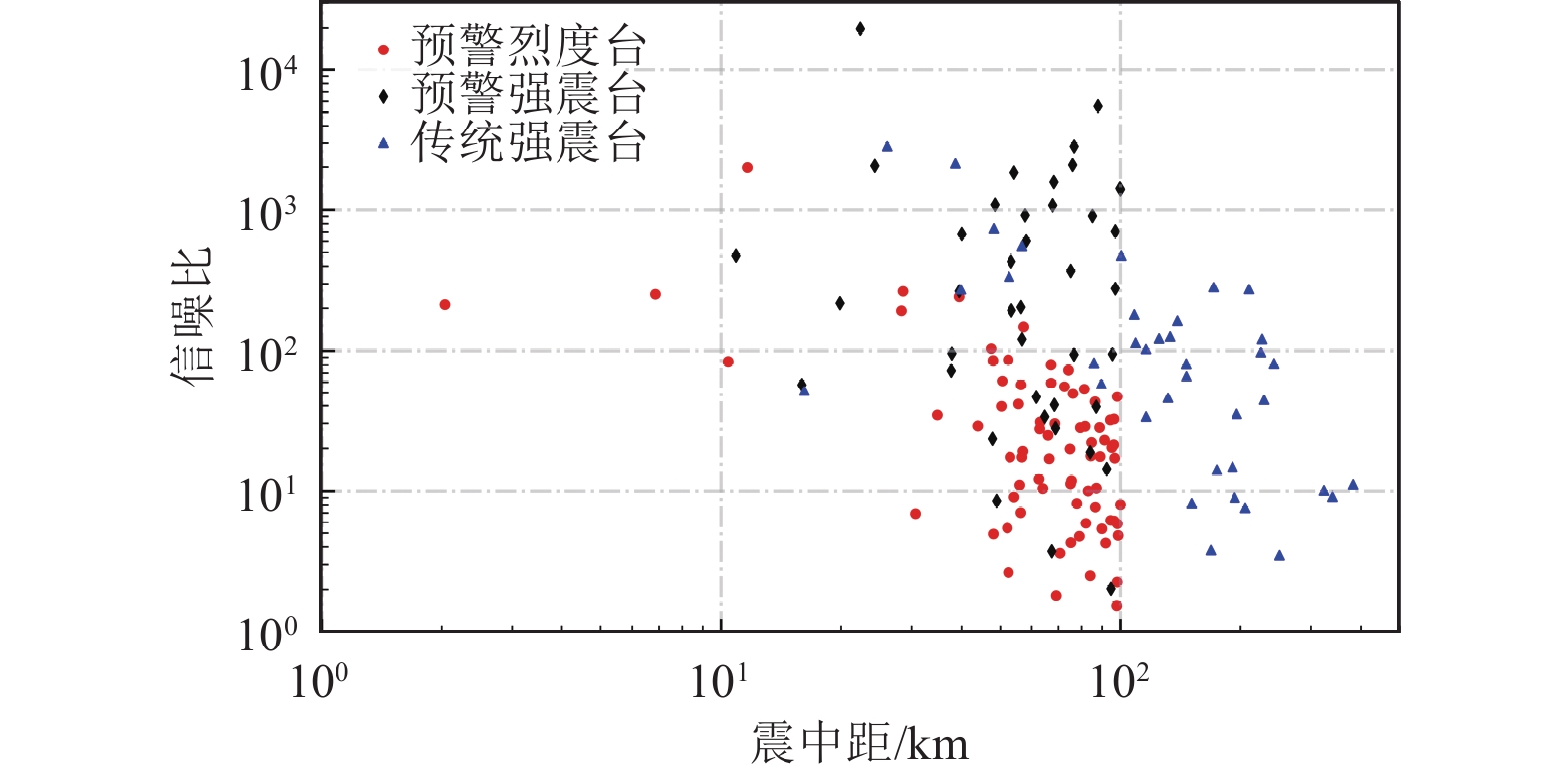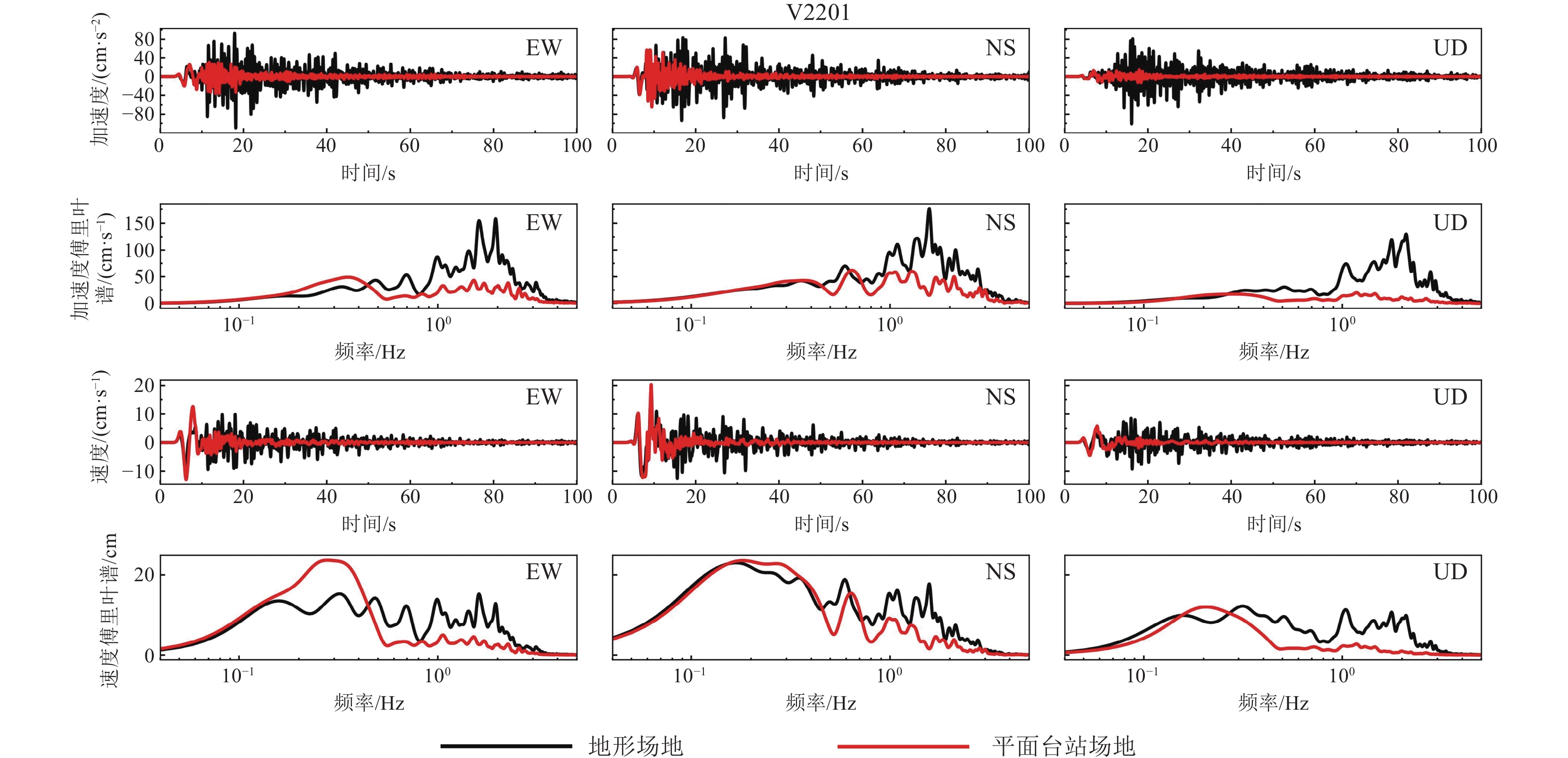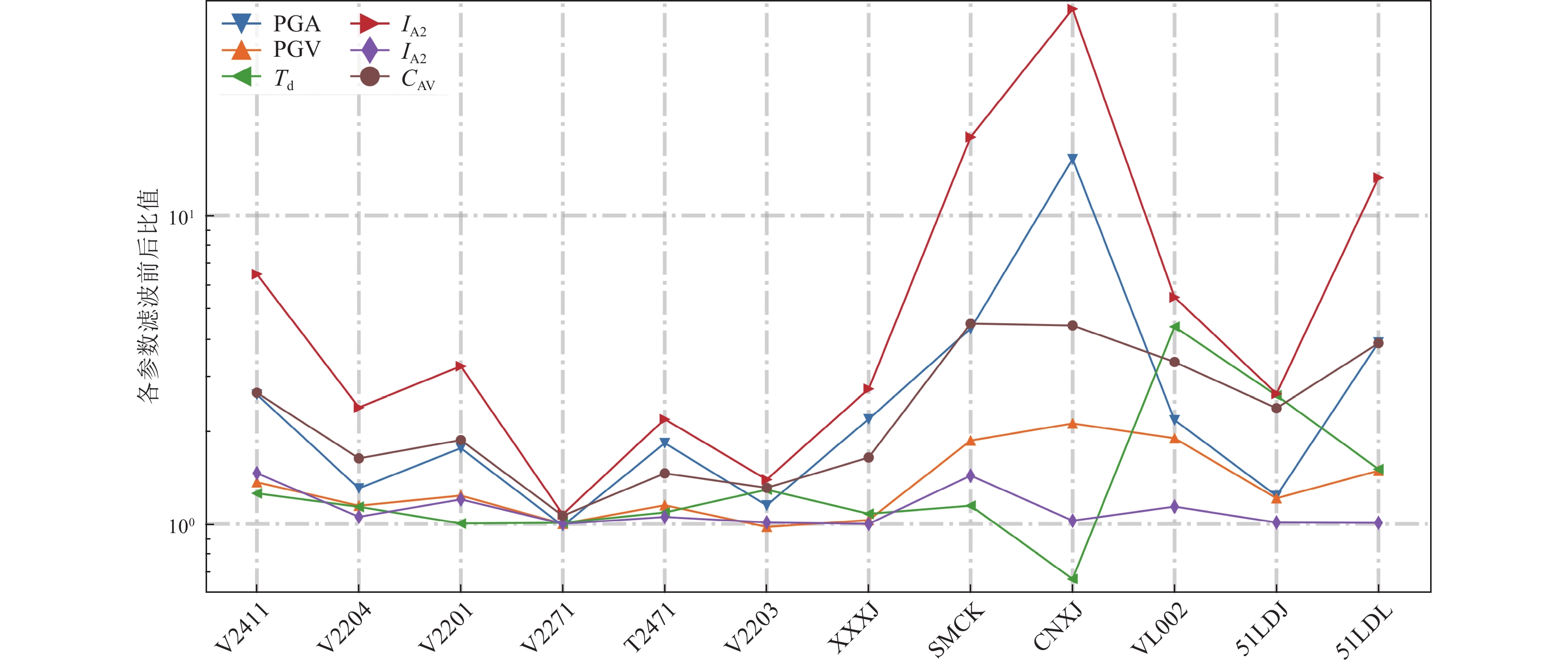Ground Motion Simulation and Topographic Site Effect of Luding Earthquake
-
摘要: 2022年9月5日四川省甘孜州泸定县境内发生MW 6.6地震,地震造成93人死亡、25人失联,423人受伤,给人民群众生命财产安全造成重大损失。本次地震震中位于青藏高原东部边缘,高山峡谷地貌形态突出,由此引发的地震动地形效应不容忽视。本文基于谱元方法模拟了泸定地震近断层地震动,并分析了地形场地效应的影响。在有效模拟频带范围内,得到如下结论:(1)相较于平面自由场,山谷地震动持时会增加约2倍左右,且在破裂方向上会更加明显;(2)山谷台站的三分量合成加速度峰值(PGA)放大系数普遍大于三分量合成速度峰值(PGV)放大系数,最大不超过2;(3)山谷地形使得地震动的累计绝对速度(CAV)增大2~4倍。地形能够引起地震动持时的放大,在重大工程紧急处置参数确定中应当考虑地形场地效应的影响。Abstract: An MW 6.6 earthquake occurred in Luding County, Ganzi Prefecture, Sichuan Province on September 5, 2022. This earthquake caused 93 deaths, 25 loss of contact and 423 injuries, causing major losses to the safety of people’s lives and property. The epicenter of this earthquake is located at the eastern edge of the Qinghai-Tibet Plateau, with prominent mountains and valleys. The topographic site effects cannot be ignored. In this paper, the near-fault ground motion of the Luding earthquake is simulated based on the spectral element method, and the influence of topographic site effects is analyzed. Within the effective frequency range, there are the following conclusions: (1) The duration of ground motion of the valley site is about 2 times of that in the far free field site, and it is more obvious along the strike; (2) The amplification factor of the three-component synthetic PGA (Peak Ground Acceleration) of the valley site is generally greater than that of the PGV (Peak Ground Velocity), but the maximum is not exceed 2; (3) The valley topography makes the CAV (Cumulative absolute velocity) of the ground motion increased by 2 to 4 times. The topography can lead to the amplification of ground motion duration, and the influence of topographic site effects should be considered in determining emergency response parameters for major projects.
-
表 1 泸定地震震源参数
Table 1. Source parameters of the Luding earthquake
震源位置 震源机制 长度/km 宽度/km 矩震级MW 经度/(°E) 纬度/(°N) 深度/km 走向/(°) 倾角/(°) 滑动角/(°) 102.109 29.524 5.76 167.37 72 — 30 16 6.59 注:相关震源参数参考韩炳权等(2023)。 表 2 台站信息
Table 2. Information of stations
台站名 经度/(°E) 纬度/(°N) 震中距/km 震中方位角/(°) 备注 V2411 102.09 29.61 2.0 202.4 预警烈度台 V2204 102.13 29.64 6.9 220.5 预警烈度台 V2201 102.19 29.58 10.4 275.5 预警烈度台 V2271 102.18 29.53 11.6 306.9 预警烈度台 T2471 102.23 29.37 28.3 329.1 预警烈度台 V2203 102.20 29.83 28.5 204.2 预警烈度台 XXXJ 102.08 29.73 16.0 178.6 预警强震台 SMCK 102.14 29.42 19.9 343.6 预警强震台 CNXJ 102.21 29.76 22.3 212.5 预警强震台 VL002 102.25 29.76 24.3 221.2 预警强震台 51 LDJ 102.21 29.69 16.2 228.4 传统强震台 51 LDL 102.23 29.79 26.1 213.6 传统强震台 -
巴振宁,赵靖轩,张郁山等,2023. 基于GP14.3运动学混合震源模型和SPECFEM 3D谱元法的宽频地震动模拟. 地球物理学报,66(3):1125−1138. doi: 10.6038/cjg2022Q0181Ba Z. N., Zhao J. X., Zhang Y. S., et al., 2023. Broadband Ground Motion Spectral Element Simulation based on GP14.3 Kinematic Hybrid Source Model and SPECFEM 3D. Chinese Journal of Geophysics, 66(3): 1125−1138. (in Chinese) doi: 10.6038/cjg2022Q0181 高玉峰,2019. 河谷场地地震波传播解析模型及放大效应. 岩土工程学报,41(1):1−25. doi: 10.11779/CJGE201901001Gao Y. F., 2019. Analytical models and amplification effects of seismic wave propagation in canyon sites. Chinese Journal of Geotechnical Engineering, 41(1): 1−25. (in Chinese) doi: 10.11779/CJGE201901001 韩炳权,刘振江,陈博等,2023. 2022年泸定Mw 6.6地震InSAR同震形变与滑动分布. 武汉大学学报•信息科学版,48(1):36−46.Han B. Q., Liu Z. J., Chen B., et al., 2023. Coseismic deformation and slip distribution of the 2022 Luding Mw 6.6 earthquake revealed by InSAR observations. Geomatics and Information Science of Wuhan University, 48(1): 36−46. (in Chinese) 李平,刘红帅,薄景山等,2016. 汶川Ms8.0地震河谷地形对汉源县城高烈度异常的影响. 地球物理学报,59(1):174−184. doi: 10.6038/cjg20160115Li P., Liu H. S., Bo J. S., et al., 2016. Effects of river valley topography on anomalously high intensity in the Hanyuan town during the Wenchuan Ms 8.0 earthquake. Chinese Journal of Geophysics, 59(1): 174−184. (in Chinese) doi: 10.6038/cjg20160115 马强,金星,李山有等,2013. 用于地震预警的P波震相到时自动拾取. 地球物理学报,56(7):2313−2321. doi: 10.6038/cjg20130718Ma Q., Jin X., Li S. Y., et al., 2013. Automatic P-arrival detection for earthquake early waning. Chinese Journal of Geophysics, 56(7): 2313−2321. (in Chinese) doi: 10.6038/cjg20130718 周国良,李小军,侯春林等,2012. SV波入射下河谷地形地震动分布特征分析. 岩土力学,33(4):1161−1166. doi: 10.3969/j.issn.1000-7598.2012.04.029Zhou G. L., Li X. J., Hou C. L., et al., 2012. Characteristic analysis of ground motions of canyon topography under incident SV seismic waves. Rock and Soil Mechanics, 33(4): 1161−1166. (in Chinese) doi: 10.3969/j.issn.1000-7598.2012.04.029 Allen T. I., Wald D. J., 2009. On the use of high-resolution topographic data as a proxy for seismic site conditions (VS30). Bulletin of the Seismological Society of America, 99(2A): 935−943. doi: 10.1785/0120080255 Assimaki D., Gazetas G., Kausel E., 2005. Effects of local soil conditions on the topographic aggravation of seismic motion: parametric investigation and recorded field evidence from the 1999 Athens earthquake. Bulletin of the Seismological Society of America, 95(3): 1059−1089. doi: 10.1785/0120040055 Brocher T. M., 2005. Empirical relations between elastic wavespeeds and density in the earth's crust. Bulletin of the Seismological Society of America, 95(6): 2081−2092. doi: 10.1785/0120050077 Dorn R. I., 2014. Chronology of rock falls and slides in a desert mountain range: case study from the Sonoran desert in South-central Arizona. Geomorphology, 223: 81−89. doi: 10.1016/j.geomorph.2014.07.005 Gao Y. F., Zhang N., Li D. Y., et al., 2012. Effects of topographic amplification induced by a U-shaped canyon on seismic waves. Bulletin of the Seismological Society of America, 102(4): 1748−1763. doi: 10.1785/0120110306 Geli L., Bard P. Y., Jullien B., 1988. The effect of topography on earthquake ground motion: a review and new results. Bulletin of the Seismological Society of America, 78(1): 42−63. doi: 10.1785/BSSA0780010042 Graves R. W., Pitarka A., 2010. Broadband ground-motion simulation using a hybrid approach. Bulletin of the Seismological Society of America, 100(5A): 2095−2123. doi: 10.1785/0120100057 Heath D. C., Wald D. J., Worden C. B., et al., 2020. A global hybrid VS30 map with a topographic slope–based default and regional map insets. Earthquake Spectra, 36(3): 1570−1584. doi: 10.1177/8755293020911137 Huang D. R., Sun P. G., Jin F., et al., 2021. Topographic amplification of ground motions incorporating uncertainty in subsurface soils with extensive geological borehole data. Soil Dynamics and Earthquake Engineering, 141: 106441. doi: 10.1016/j.soildyn.2020.106441 Igel H. , 2017. Computational seismology: a practical introduction. Oxford: Oxford University Press, 199−209. Komatitsch D., Vilotte J. P., 1998. The spectral element method: an efficient tool to simulate the seismic response of 2D and 3D geological structures. Bulletin of the Seismological Society of America, 88(2): 368−392. doi: 10.1785/BSSA0880020368 Komatitsch D., Tromp J., 1999. Introduction to the spectral element method for three-dimensional seismic wave propagation. Geophysical Journal International, 139(3): 806−822. doi: 10.1046/j.1365-246x.1999.00967.x Komatitsch D., Liu Q. Y., Tromp J., et al., 2004. Simulations of ground motion in the Los Angeles Basin based upon the spectral-element method. Bulletin of the Seismological Society of America, 94(1): 187−206. doi: 10.1785/0120030077 Komatitsch D. , Tsuboi S. , Tromp J. , et al. , 2005. The spectral-element method in seismology. In: Levander A. , Nolet G. , eds. , Seismic Earth: Array Analysis of Broadband Seismograms, Volume 157. Washington: American Geophysical Union, 205. Kuhlemeyer R. L., Lysmer J., 1973. Finite element method accuracy for wave propagation problems. Journal of the Soil Mechanics and Foundations Division, 99(5): 421−427. doi: 10.1061/JSFEAQ.0001885 Lee S. J., Chen H. W., Liu Q. Y., et al., 2008. Three-dimensional simulations of seismic-wave propagation in the Taipei basin with realistic topography based upon the spectral-element method. Bulletin of the Seismological Society of America, 98(1): 253−264. doi: 10.1785/0120070033 Lee S. J., Chan Y. C., Komatitsch D., et al., 2009. Effects of realistic surface topography on seismic ground motion in the Yangminshan region of Taiwan based upon the spectral-element method and LiDAR DTM. Bulletin of the Seismological Society of America, 99(2A): 681−693. doi: 10.1785/0120080264 Liu Y., Yao H. J., Zhang H. J., et al., 2021. The community velocity model V. 1.0 of Southwest China, constructed from joint body- and surface-wave travel-time tomography. Seismological Research Letters, 92(5): 2972−2987. doi: 10.1785/0220200318 Ma Q., Wang F. C., Tao D. W., et al., 2021. Topographic site effects of Xishan park ridge in Zigong city, Sichuan considering epicentral distance. Journal of Seismology, 25(6): 1537−1555. doi: 10.1007/s10950-021-10048-7 Patera A. T., 1984. A spectral element method for fluid dynamics: laminar flow in a channel expansion. Journal of Computational Physics, 54(3): 468−488. doi: 10.1016/0021-9991(84)90128-1 Sepúlveda S. A., Murphy W., Jibson R. W., et al., 2005. Seismically induced rock slope failures resulting from topographic amplification of strong ground motions: the case of Pacoima Canyon, California. Engineering Geology, 80(3-4): 336−348. doi: 10.1016/j.enggeo.2005.07.004 Somerville P., Irikura K., Graves R., et al., 1999. Characterizing crustal earthquake slip models for the prediction of strong ground motion. Seismological Research Letters, 70(1): 59−80. doi: 10.1785/gssrl.70.1.59 Stone I., Wirth E. A., Frankel A. D., 2022. Topographic response to simulated Mw 6.5−7.0 earthquakes on the Seattle fault. Bulletin of the Seismological Society of America, 112(3): 1436−1462. doi: 10.1785/0120210269 Wald D. J., Allen T. I., 2007. Topographic slope as a proxy for seismic site conditions and amplification. Bulletin of the Seismological Society of America, 97(5): 1379−1395. doi: 10.1785/0120060267 Wang G., Du C. Y., Huang D. R., et al., 2018. Parametric models for 3D topographic amplification of ground motions considering subsurface soils. Soil Dynamics and Earthquake Engineering, 115: 41−54. doi: 10.1016/j.soildyn.2018.07.018 Wang X. C., Wang J. T., Zhang L., et al., 2021a. A multidimension source model for generating broadband ground motions with deterministic 3D numerical simulations. Bulletin of the Seismological Society of America, 111(2): 989−1013. doi: 10.1785/0120200221 Wang X. C., Wang J. T., Zhang L., et al., 2021b. Broadband ground-motion simulations by coupling regional velocity structures with the geophysical information of specific sites. Soil Dynamics and Earthquake Engineering, 145: 106695. doi: 10.1016/j.soildyn.2021.106695 Yuan Y. O., Lacasse M. D., Liu F. S., 2021. Full-wavefield, full-domain deterministic modeling of shallow low-magnitude events for improving regional ground-motion predictions. Bulletin of the Seismological Society of America, 111(5): 2617−2634. doi: 10.1785/0120210031 -



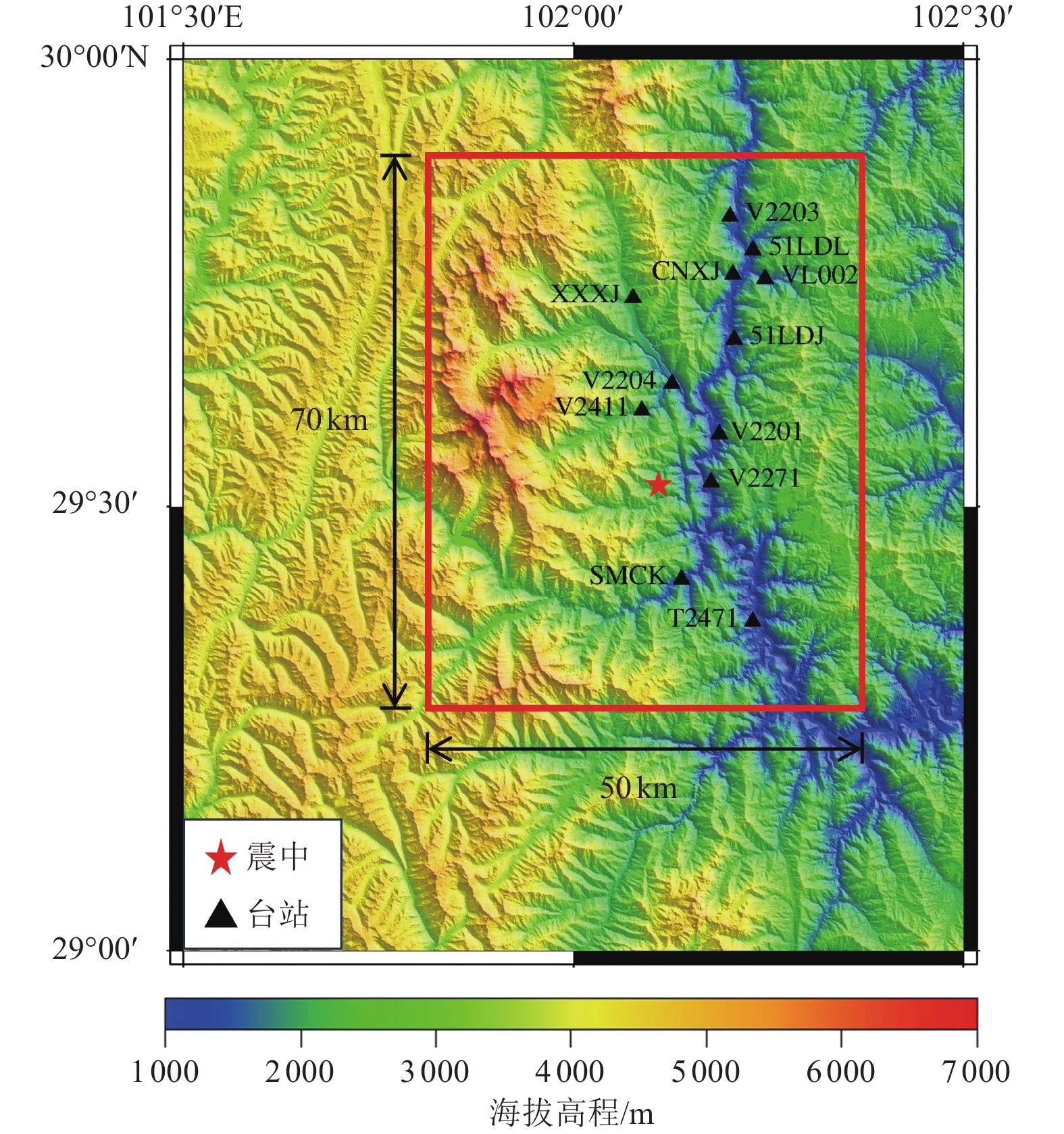
 下载:
下载:
